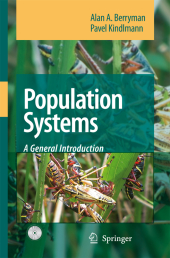 Neuerscheinungen 2014Stand: 2020-02-01 |
Schnellsuche
ISBN/Stichwort/Autor
|
Herderstraße 10
10625 Berlin
Tel.: 030 315 714 16
Fax 030 315 714 14
info@buchspektrum.de |

Alan A. Berryman, Pavel Kindlmann
(Beteiligte)
Population Systems
A General Introduction
2. Aufl. 2014. xv, 222 S. 235 mm
Verlag/Jahr: SPRINGER NETHERLANDS; SPRINGER 2014
ISBN: 9400798369 (9400798369)
Neue ISBN: 978-9400798366 (9789400798366)
Preis und Lieferzeit: Bitte klicken
This book is concerned with the general principles and theories of population ecology. It presents a completely unique approach, based on a simple set of general rules governing the population interactions.
This unique book is concerned with the general principles and theories of population ecology, based on the idea that the rules governing the dynamics of populations are relatively simple, and that the rich behavior we observe in nature is a consequence of the structure of the system rather than of the complexity of the underlying rules. From this perspective, the dynamic behavior of single-species populations is examined and an elementary feedback model of the population system is developed. This single-species model is refined and generalized by examining the mechanisms of population regulation.
Contents. Preface to the first edition. Preface to the second edition. Acknowledgements. Part I. Population Systems. Introduction to Part I. 1. A Brief Look at General Systems. 1.1. What is a System? 1.2. The State of a System. 1.3. Dynamic Systems. 1.4. System Diagrams. 1.5. Feedback Control. 1.6. The Stability of Systems. 1.7. Anticipatory Feedforward. 1.8. Systems Analysis in Biology. 1.9. Chapter Summary. Exercises. Notes. 2. Population Dynamics and an Elementary Model. 2.1. What is a Population? 2.2. Dynamics in Populations. 2.3. An Elementary Population Model. 2.4. Analysis of the Model. 2.5. Environmental and Genetic Effects. 2.6. Chapter Summary. Exercises. Notes. 3. Population Regulation and a General Model. 3.1. Density-Dependant Mechanisms. 3.1.1. Competitive Processes. 3.1.2. Cooperative Processes. 3.2. Feedback Integration. 3.3. A General Population Model. 3.4. Analysis of the Model. 3.4.1. Environmental and Genetic Effects. 3.5. Populations in Changing Environments. 3.5.1. Environmental Feedback. 3.6. Complex Density-Dependant Relationships. 3.7. Chapter Summary. Exercises. Notes. Part II. Systems of Interacting Populations. Introduction to Part II. 4. Interactions between Two Species. 4.1. Population Interactions. 4.2. Cooperative Interactions. 4.3. Competitive Interactions. 4.3.1. Nonlinear Competitive Interactions. 4.3.2. Competition in Variable Environments. 4.3.3. Strategies of the Competitor. 4.4. Predator-Prey Interactions. 4.4.1. Nonlinear Predator-Prey Interactions. 4.4.2. Predator Functional Responses. 4.4.3. Predation in Variable Environments. 4.4.4. Predator and Prey Strategies. 4.5. Chapter Summary. Exercises. Notes. 5. Interactions in Space. 5.1. Introduction. 5.2. Movements in Space. 5.3. Dynamics in Space. 5.4. The Spread and Collapse of Pest Epidemics. 5.5. Stability in Space. 5.6. Population Quality in Space. 5.7. Environmental Stratification. 5.8. Chapter Summary. Notes. 6. Interactions between many Species (Ecological Communities). 6.1. Community Structure. 6.2. Community Stability. 6.2.1. Predation as a Stabilizing Influence. 6.3. Community Dynamics. 6.4. Chapter Summary. Exercises. Notes. Epilogue: The Human Dilemma. Answers to Exercises. Author Index. Subject Index.


